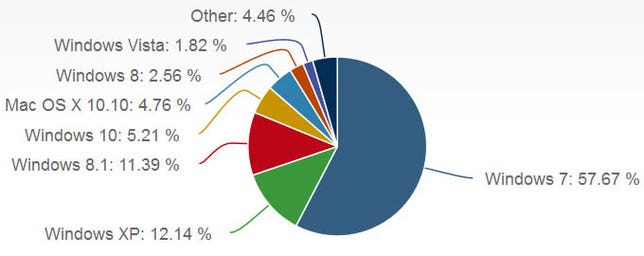 Enlarge Image
Enlarge ImageWindows 10 fared well during its first month out, helped by Windows 7 and 8.1 users eligible for a free upgrade.
NetMarketShare
Windows 10 is firmly in fourth place among desktop operating systems, according to stats released Tuesday.
Microsoft’s newly launched software grabbed a 5.21 percent share of all Web traffic generated by desktop operating systems in August, according to NetMarketShare. Windows 10 had been available as a technical preview since last October. But it barely registered as a blip on NetMarketShare’s radar until it became available as a free upgrade to Windows 7 and 8.1 users starting July 29.
Among all desktop operating systems, Windows 10 ranked fourth in Web traffic last month, behind Windows 8.1, Windows XP and Windows 7 but ahead of Windows 8 and Mac OS X Yosemite.
Microsoft has been counting on Windows 10 to win back the love it lost with Windows 8, which rolled out three years ago but failed to catch on with the desktop crowd. To lure users to its new operating system, the software giant has revived the Start menu, tweaked the Start screen, added its Cortana voice assistant and made a variety of other improvements to the overall design and layout. PC sales are also in a slump, while Microsoft’s share of the mobile market is in the dumps. Windows 10 is designed to work across a variety of devices from PCs to tablets to mobile phones. So Microsoft is looking to its newest version of Windows to grab more users across its entire ecosystem.
So far, Windows 10 adoption is far outpacing that of Windows 8 over a similar time frame. After Windows 8 officially launched on October 27 of 2012, it scraped up just a 1 percent share of Web traffic in November, according to NetMarketShare. Its share continued to rise at a slow pace and didn’t reach 5 percent until the following June.
Of course, everyone likes a freebie, so the comparison isn’t totally fair. Windows 10 is currently available for free to Windows 7 and 8.1 users. The Windows 8 upgrade initially cost $40 for most users of Windows 7, Vista, and XP and $15 for recent purchasers. Still, that deal ended on January 31 of 2013, after which the upgrade price jumped to $120 for the regular edition and $200 for the Pro version. So beyond just the free offer, the new features in Windows 10 are likely prompting many users to upgrade, especially those who want to get away from Windows 8.1.
Microsoft has also naturally been touting the quick uptake of Windows 10. On July 31, just a couple of days after launch date, the company said that Windows 10 has already been running on 14 million devices. On August 26, a little less than a month later, Microsoft said that its new software was installed on more than 75 million devices worldwide.
Windows 10’s appeal is also trickling down to Microsoft’s new Edge browser . For the month of August, Edge took home a 2 percent cut of all browser traffic as seen by NetMarketShare. Designed as a sleeker and simpler alternative to the aging Internet Explorer, Edge is available only in Windows 10. A 2 percent share for the first month isn’t bad. But keep in mind that Edge is set up as the default browser in Windows 10. So switching the default to Firefox, Chrome or even Internet Explorer involves a few steps that many users may not be aware of or bother to take if Edge is getting the job done.
Among all desktop operating systems, Windows 7 remained on top last month with a Web traffic share of 57.6 percent, followed by Windows XP with 12 percent and Windows 8.1 with 11.4 percent.




